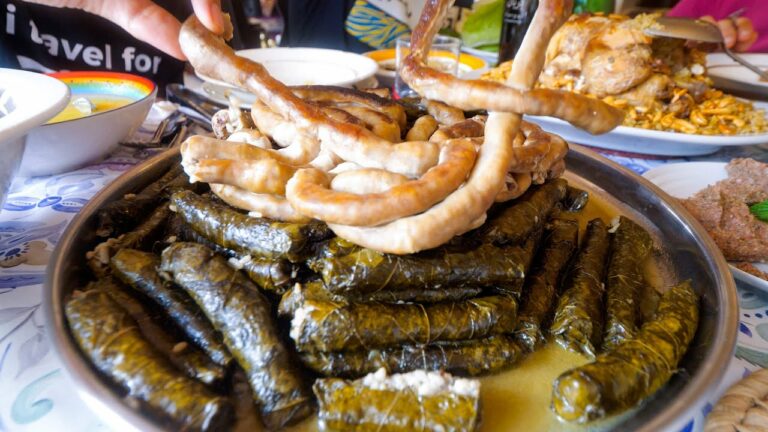Introduction to Lebanese cuisine
Lebanese cuisine is a combination of Middle Eastern and Mediterranean influences. It is characterized by its fresh and flavorful ingredients, including herbs, spices, vegetables, fruits, and meat. Lebanese cuisine is known for its mezze, which is a variety of small dishes typically served before a meal. Mezze dishes can range from cold salads and dips to hot appetizers and grilled meats.
The culture of snacking in Lebanon
In Lebanon, snacking is an important part of everyday life. The Lebanese people enjoy eating small meals throughout the day, rather than three large meals. This allows them to sample a variety of different dishes and flavors. Snacking is also a social activity in Lebanon, where people gather with friends and family to share food and conversation. It is common to see Lebanese people snacking on the go, whether it be in street food stalls or at the office.
Common ingredients used in Lebanese snacks
Lebanese snacks are typically made from fresh and natural ingredients. Common ingredients include olive oil, garlic, lemon juice, parsley, mint, and yogurt. Vegetables such as tomatoes, cucumbers, and eggplants are also commonly used in Lebanese snacks. Lebanese cuisine is known for its use of spices, including cumin, coriander, and sumac. Meat is also a common ingredient in Lebanese snacks, with lamb and chicken being popular choices.
Traditional Lebanese snacks and appetizers
Some of the most popular Lebanese snacks and appetizers include hummus, tabbouleh, falafel, kibbeh, and fatayer. Hummus is a dip made from chickpeas, tahini, garlic, and lemon juice. Tabbouleh is a salad made from parsley, tomatoes, onions, and bulgur wheat. Falafel is a deep-fried patty made from ground chickpeas and spices. Kibbeh is a meat pie made from bulgur wheat and ground beef or lamb. Fatayer is a savory pastry filled with spinach, cheese, or meat.
Recipes for Lebanese snacks and appetizers
Here are some recipes for traditional Lebanese snacks and appetizers:
Hummus
- 1 can chickpeas, drained and rinsed
- 2 cloves garlic, minced
- 1/4 cup tahini
- 1/4 cup lemon juice
- 2 tbsp olive oil
- Salt and pepper to taste
Combine all ingredients in a food processor and blend until smooth. Add water as needed to achieve desired consistency. Serve with pita bread or vegetables.
Falafel
- 1 cup dried chickpeas, soaked overnight
- 1/2 onion, chopped
- 2 cloves garlic, minced
- 1/4 cup chopped parsley
- 1/4 cup chopped cilantro
- 1 tsp cumin
- 1 tsp coriander
- Salt and pepper to taste
- Vegetable oil for frying
Drain the chickpeas and add them to a food processor with the onion, garlic, parsley, cilantro, cumin, coriander, salt, and pepper. Pulse until the mixture is finely ground. Form the mixture into small patties and fry in hot oil until golden brown.
Fatayer
- 2 cups flour
- 1 tsp instant yeast
- 1/4 tsp salt
- 1/4 cup olive oil
- 1/2 cup warm water
- 2 cups chopped spinach
- 1/2 onion, chopped
- 1/4 cup chopped parsley
- 1/4 cup chopped mint
- 1/4 cup crumbled feta cheese
- Salt and pepper to taste
In a large bowl, combine the flour, yeast, and salt. Add the olive oil and warm water and knead until a smooth dough forms. Let the dough rise for 1 hour. In a separate bowl, mix together the spinach, onion, parsley, mint, feta cheese, salt, and pepper. Roll the dough into small circles and fill with the spinach mixture. Bake at 350°F for 20-25 minutes.
Conclusion: Importance of Lebanese snacking culture
Lebanese snacking culture is an important part of the country’s culinary heritage. It allows people to sample a variety of flavors and dishes, and provides an opportunity for socializing and gathering with friends and family. Lebanese snacks and appetizers are made from fresh and natural ingredients, and are known for their bold flavors and spices. Whether enjoyed at a street food stall or in the comfort of one’s home, Lebanese snacks and appetizers are a delicious and satisfying way to experience the flavors of this vibrant culture.

